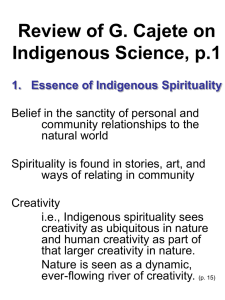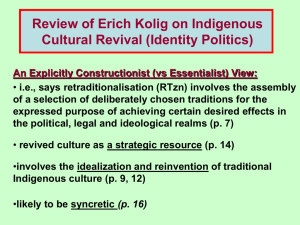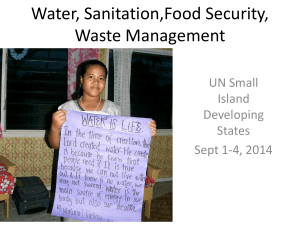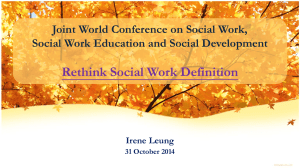Indigenous Peoples` Interests and the Oil
advertisement
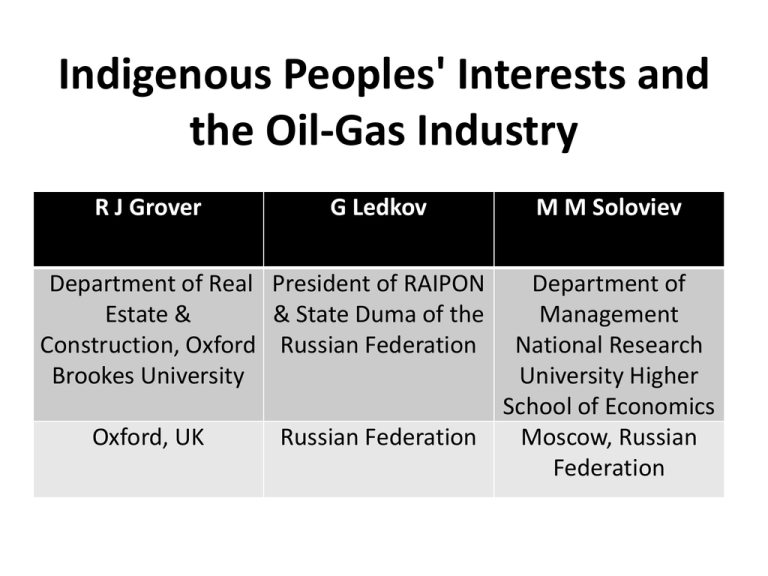
Indigenous Peoples' Interests and the Oil-Gas Industry R J Grover G Ledkov Department of Real President of RAIPON Estate & & State Duma of the Construction, Oxford Russian Federation Brookes University Oxford, UK Russian Federation M M Soloviev Department of Management National Research University Higher School of Economics Moscow, Russian Federation The problem with oil and gas exploitation • Governments tend to regard oil and gas reserves as a strategic national resource • Their exploitation has significant impact eg test wells, extraction boreholes, collection pipelines, pumping stations, export pipelines, housing and facilities for workers, roads, landfills, power plants, maintenance facilities • Exploitation involves displacing other activities eg farming, hunting, fishing, plant collection Issues with oil and gas exploitation in the Arctic • Severe climate places exploitation at technological frontier eg liquefaction of gas • Fragile natural environment that takes a long time to recover from ecological damage • Region has poor infrastructure – has to be constructed by industry • Low density of population so workforce tends to be imported – local population do not have many of the skills required • Region is remote from consumers requiring expensive delivery systems Compulsory purchase compensation • Intended to compensate losers so that they are no worse off as a result of losing land or damage to land retained. • Assumes that losers can take their compensation and acquire equivalent properties. • But what if way of life is destroyed so that there are no equivalent properties? History of resource exploitation in Northern regions suggests this is the case – human disturbance of flora and fauna and impact on their reproductive rates Environmental Impact of development (United Nations Environment Programme) Two case studies illustrating alternative approaches • Russian Federation Yamal Nenets Automoous Okrug – compensation determined by precise methodology to calculate total of different types of loss. • Alaska and Canada where the issue of compensation is linked to that of land right claims by indigenous population. Industrial development of Circumpolar region Yamal-Nenets Autonomous Okrug Moscow Attitudes of oil and gas companies • Oil and gas companies have corporate social and environmental responsibility policies • Have western investors, partners and lenders • Seek to comply with ISO 14000 (Environmental Management) and ISO 26000 (Social Responsibility) standards • Adopt policies like underground laying of pipelines, avoid blocking animal migration routes, and reducing impact on ecology Russian approach to indigenous peoples Russian Federation laws do not use the definitions employed by the International Labour Organisation ILO C107 Indigenous and Tribal Populations Convention, 1957 (more widely ratified than 1987 Convention) “1. This Convention applies to-(a) members of tribal or semi-tribal populations in independent countries whose social and economic conditions are at a less advanced stage than the stage reached by the other sections of the national community, and whose status is regulated wholly or partially by their own customs or traditions or by special laws or regulations; (b) members of tribal or semi-tribal populations in independent countries which are regarded as indigenous on account of their descent from the populations which inhabited the country, or a geographical region to which the country belongs, at the time of conquest or colonisation and which, irrespective of their legal status, live more in conformity with the social, economic and cultural institutions of that time than with the institutions of the nation to which they belong.” • Russian Federation gives special status and protection to groups with less than 50,000 members eg Nenets c41,000, Evenki c30,000 (21,000 in Sakha Autonomous Republic) but not Sakha (Yakut) 466,500 Yamal-Nenets Autonomous Okrug: Direct compensation for pipeline building – principles for compensation • Compensation varies according to the value of the economic losses from destruction, alienation, degradation or burden. • Compensation according to geo-botanic characteristics, nature and duration of external influences (such as the building process and the industrial exploitation period), the kind of external organizations, industrial and other activities and the character and intensity of its influence on the built environment. • The calculation of the external stress on land sites according to the regional and local characteristics. • The use of the average annual gross revenue per hectare of land as the basis for estimating losses. • The use of geo-botanical contour maps as the basis for defining the characteristics of land . • The calculation of losses separately for every specified site and different time periods of building and exploitation activities of industrial and support companies. • The calculation of losses separately for all the types of activities of the indigenous population activities on the specified land sites according to an officially approved list of 13 indigenous traditional activities, such as animalhusbandry (reindeer-breeding, horse-breeding, etc.), animal-husbandry products processing, fur farming, dog-breeding, fur trading, sea and river fishing, local market gardening, and medicinal herb collecting. Alaska • Unresolved issue of native land claims from 1867 US purchase from Russia – who are the “uncivilised native tribes” referred to in Treaty? • 1968 Prudhoe Bay oilfield on land owned by State of Alaska but need for export to ice-free port by pipeline across land owned or claimed by indigenous populations • Alaska Native Claims Settlement Act 1971 – US extinguished land claims, granted 44 million acres to native corporations and paid them $962.5m • 13 regional corporations – own surface and sub-surface rights • 229 village corporations – own surface rights • Native corporations are for-profit organisations – can sell and mortgage land – can go bankrupt Alaskan Native Corporations – big business Owned by 11,000 Iñupiat Eskimo shareholders, living mainly in eight villages on Alaska’s North Slope 5 million acres with oil, gas, coal and other minerals Revenues $1,945 million in 2009, $163.5 million for shareholders 10,000 employees Construction, energy services, government contracting, financial services, hotels, petroleum refining Operates outside Alaska eg Gulf States Current and potential development of Mackenzie Basin 1789 Alexander Mackenzie reports oil in Mackenzie Delta 1920 wildcat strike Fort Norman leads to oil for local demand and military Potential export route from Prudhoe Bay Historic approach to development on indigenous peoples’ lands in Canada: Moose Lake, Manitoba • Moose Lake in Northern Manitoba on the Saskatchewan River Delta, populated by Cree and Métis. • 1963-4 two-thirds of reserve flooded for Grand Rapids hydro dam - Population had to move • Loss of farmland used for grain, cattle and fur farming – fur farming produced $150,000 pa • Loss of hunting and trapping land and commercial duck shooting ($207,000 pa) • Loss of commercial fishery • Compensation $10,000 • Exposure to pollutants through food chain – mercury form pulp mills, uranium • Destruction of local society and creation of social stress Changing attitudes in Canada • Calder v the Attorney General of British Columbia (1973) ruled that Indian title was a legal right independent of any form of enactment – not extinguished by colonisation. • 1977 Berger Inquiry: Northern Frontier Northern Homeland: The Report of the Mackenzie Valley Pipeline Inquiry – Conflict of interest between businesses and aboriginal groups – Impossible to impose conditions on pipeline construction to protect the environment – Unlike transitory European population, indigenous population could not move easily to other parts of Canada – Proposed moratorium on development until the native land claims had been resolved ie indigenous population could then determine their own future • 1982 Constitution Act reaffirmed aboriginal and treaty rights • Canadian Government’s Comprehensive Land Settlement process Opening up the Mackenzie Valley • Renewed interest after 2000 cue to rise in price of natural gas • Substantial progress on settlement of land claims in area – – – – – Inuvialuit final agreement 1984 & 1987 Gwich’in comprehensive land agreement 1992 Sahtu 1993 Dehcho agreement in principle 2007 • 2001 Mackenzie Valley Aboriginal Pipeline Corporation MoU with Imperial Oil, Connoco Phillips, Shell and Exxon – 2003 full participant with 33.3% share of consortium Alternative approaches to developing oil-gas fields • Russian Federation - compensation to officially recognised indigenous juridical bodies for loss of sites in recognised tenure used for recognised traditional activities • North America – land settlement claims give indigenous population ownership rights (surface or surface & sub-surface) – can negotiate with oil/gas companies, including preferential sub-contracts. • Alaskan model – for-profit native corporations able to diversify but can go bankrupt Which model offers better potential? • No return to nomadic farming/ hunting when oil/gas runs out if environment degraded • Can alternative employment be found for people who are nomadic farmers/ hunters if environment that supported them is degraded? • Should indigenous population share in oil/gas wealth? If so in what proportion to wider society? • To what extent should government’s permit indigenous population to determine their own futures, including permitting mutually-owned native corporations to go bankrupt?



